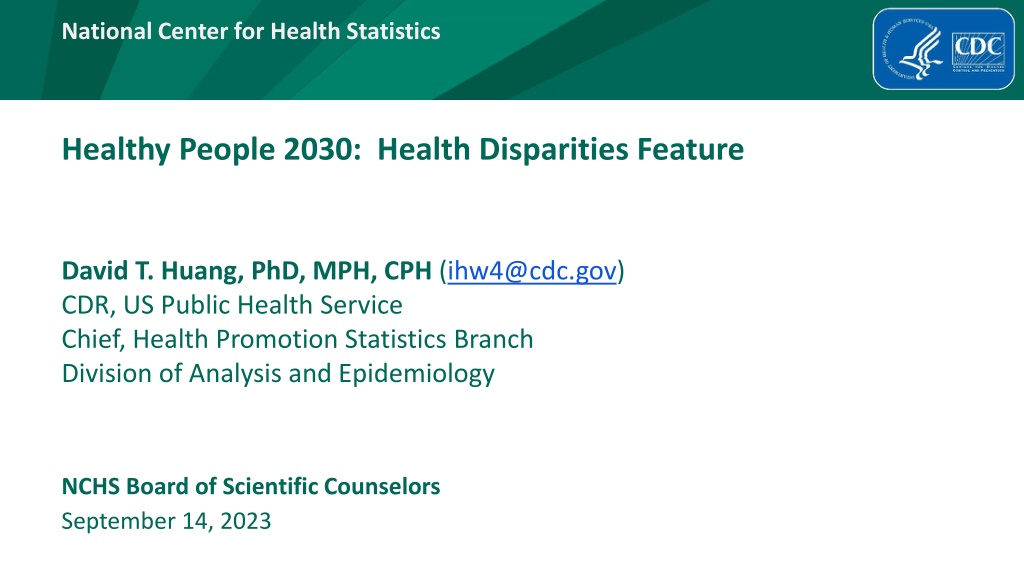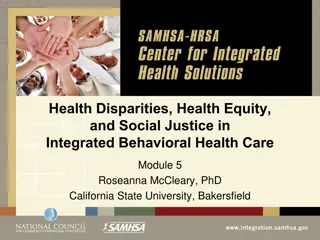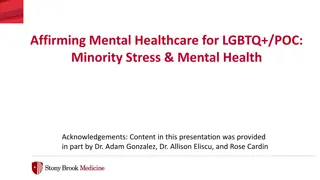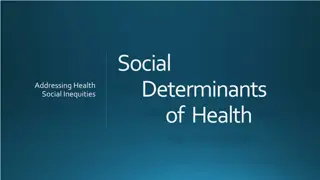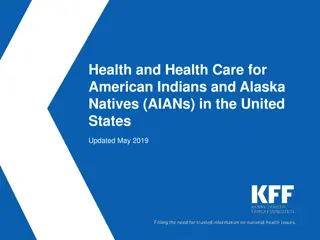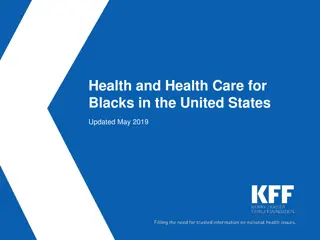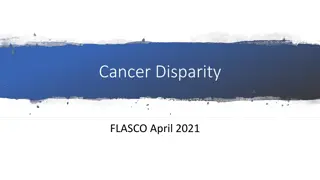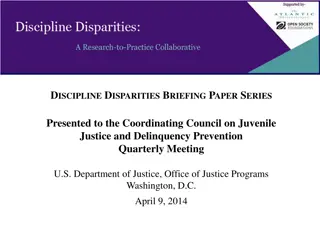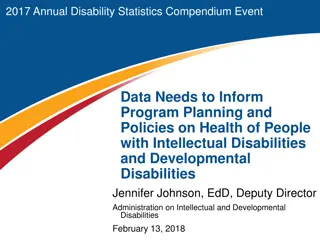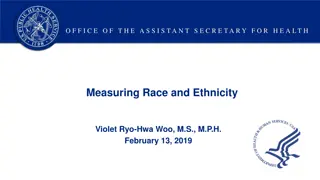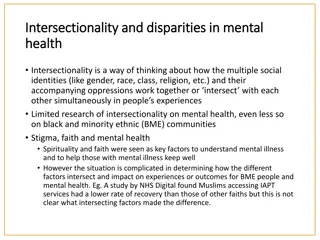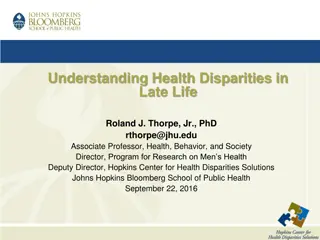Understanding Healthy People 2030: Addressing Health Disparities for National Well-being
Healthy People 2030 is a strategic framework aiming to improve health and achieve equity by setting measurable objectives to be met by the end of the decade. The National Center for Health Statistics plays a crucial role in developing statistical methods, databases, and providing technical assistance for this initiative. The history of Healthy People goals highlights the ongoing efforts to eliminate health disparities and achieve health literacy for all. Measurement factors like educational attainment, family income, health insurance status, and demographic data are essential for tracking progress towards improved health outcomes.
- Health disparities
- National Center for Health Statistics
- Healthy People 2030
- Health equity
- Statistical analysis
Download Presentation

Please find below an Image/Link to download the presentation.
The content on the website is provided AS IS for your information and personal use only. It may not be sold, licensed, or shared on other websites without obtaining consent from the author. Download presentation by click this link. If you encounter any issues during the download, it is possible that the publisher has removed the file from their server.
E N D
Presentation Transcript
National Center for Health Statistics Healthy People 2030: Health Disparities Feature David T. Huang, PhD, MPH, CPH (ihw4@cdc.gov) CDR, US Public Health Service Chief, Health Promotion Statistics Branch Division of Analysis and Epidemiology NCHS Board of Scientific Counselors September 14, 2023
What is Healthy People? Provides a strategic framework for a national prevention agenda that communicates a vision for improving health and achieving health equity Identifies science-based, measurable objectives with targets to be achieved by the end of the decade Requires tracking of data-driven outcomesto monitor progress and to motivate, guide, and focus action Offers model for international, state, and local program planning 3
Role of NCHS within Healthy People Statistical methods and measure development Healthy People databases Analysis and presentation of data Expertise and technical assistance 4
History 1985: HHS Report of the Secretary s Task Force on Black & Minority Health (Heckler Report) Healthy People Overarching Goals: HP2000: Reduce health disparities HP2010: Eliminate health disparities HP2020: Achieve health equity, eliminate disparities, and improve the health of all groups HP2030: Eliminate health disparities, achieve health equity, and attain health literacy to improve the health and well-being of all 5
Healthy People 2030 Data Template Educational Attainment < High school High school Some college or Associates degree 4-year college degree or more Family Income (percent poverty threshold) <100 100-199 200-399 >=400 Health Insurance Status Insured Private Public Uninsured Geographic Location or Region Metropolitan Nonmetropolitan Marital Status Married/Cohabiting partner Divorced or Separated/Widowed Never married Country of Birth US Outside US Total Sex Male Female Race/Ethnicity American Indian/Alaska Native only Asian only Native Hawaiian/Pacific Islander only Black or African American only White only 2 or more races Hispanic or Latino Not Hispanic or Latino American Indian/Alaska Native only, not Hispanic or Latino Asian only, not Hispanic or Latino Native Hawaiian/Pacific Islander only, not Hispanic or Latino Black only, not Hispanic or Latino White only, not Hispanic or Latino 2 or more races not Hispanic or Latino Age [Standard groups by data system] Veteran Status Veteran Non-Veteran Disability Status People with disabilities People without disabilities Sexual Orientation Straight Straight, Male Straight, Female Gay/Lesbian Gay, Male Gay/Lesbian, Female Bisexual Bisexual, Male Bisexual, Female Gender Identity [Standard groups by data system] Notes: If data are not collected, analyzed, or available (or need to be suppressed) for a particular demographic group by a data source, the demographic label will still be shown and a symbol or acronym will be displayed to indicate the reason data are not shown. With justification by the workgroup and approval by NCHS, additional population categories and subcategories may be included on a case-by-case basis.7
Disparities: Evolution of Measurement HP2000 HP2010 HP2020 HP2030 Eliminate health disparities, achieve health equity, and attain health literacy to improve the health and well-being of all Achieve health equity, eliminate disparities, and improve the health of all groups Overarching Goal Reduce health disparities Eliminate health disparities Separate targets were set designed to narrow the gap with the total population No separate disparities targets, but use of better than the best target-setting method No separate disparities targets, but we do consider progress by population group No separate disparities targets, but we do consider progress by population group Disparity Targets Absolute disparity: 1. Rate difference* 2. Maximal rate difference 3. Summary rate difference* Absolute disparity: 1. Maximal rate difference Absolute disparity: Not assessed Absolute disparity: Not assessed Relative disparity: 2. Rate ratio 3. Maximal rate ratio 4. Summary rate ratio Relative disparity: Not assessed Relative disparity: 1. Percentage difference 2. Index of disparity Relative disparity: 4. Rate ratio 5. Maximal rate ratio 6. Summary rate ratio Change in disparity over time: ratio of percent change for reference group to percent change for group of interest Measurement Change in disparity over time: absolute difference for measures above Change in disparity over time: absolute and relative difference for maximal and summary rate ratio Change in disparity over time: absolute and relative difference for measures above Reference point: Most favorable group rate Reference point: Total population Reference point: Most favorable group rate Reference point: Most favorable group rate 8 *Proposed new measures for HP2030
Absolute vs. Relative Measures Absolute disparity:simple difference between two rates (also referred to as the rate difference or absolute difference) Absolute disparities may be easier to visualize than relative disparities. Example: The maximal rate difference is the difference between the highest and the lowest group rates. Relative disparity: disparity measured relative to the group with the best rate Examples include the percent difference between rates or the ratio between rates. Relative disparities are unit-free and can be used to compare objectives with different units of measure. Example: The maximal rate ratio is the ratio of the highest to the lowest group rates. 9
Between-Group Measures Between-group measures consider disparities between exactly two group rates. For Healthy People purposes, the group rates used are: ?? = rate for the most favorable group (reference point) ?? = rate for a group of interest Examples Absolute: The rate difference is the absolute value of the simple difference: ?? ?? Relative: The rate ratio is defined as: ?? ??, if an increase is desired ?? ??, if a decrease is desired 10
Overall (Across-Group) Measures Overall (across-group) measures consider the data across multiple group rates, although their calculation may or may not incorporate more than two group rates. Examples Given ?? = rate for the most favorable group (reference point) ?? = the average of the rates for all other groups Absolute: The summary rate difference is ?? ?? ?? ??, if an increase is desired; or ?? Relative: The summary rate ratio is ??, if a decrease is desired. When there are only two groups, these measures reduce to the maximal rate difference and maximal rate ratio, respectively. The maximal rate difference and maximal rate ratio are also examples of overall (across- group) disparities measures that incorporate the smallest and largest rates in their calculation. 11
Next Steps and Takeaways As there is no single gold standard in health disparities measurement, considering multiple measures can provide a fuller context of health disparities. A forthcoming NCHS Series 2 report will document HP2030 disparities measures and expand further on their strengths and limitations. The HP2030 disparities feature provides a starting point for health disparities data and content for HP2030 objectives. Future enhancements: increased functionality additional measures disparities charts 19
References Websites: Healthy People 2030 (Main): https://health.gov/healthypeople Healthy People 2030 (Disparities): https://health.gov/healthypeople/objectives-and-data/about-disparities-data NCHS Healthy People: http://www.cdc.gov/nchs/healthy_people.htm Health Disparities Calculator (NCI): https://seer.cancer.gov/hdcalc/ Manuscripts: Braveman P. Health disparities and health equity: concepts and measurement. Annu Rev Public Health. 2006;27:167-194. https://doi.org/10.1146/annurev.publhealth.27.021405.102103 Harper et al. Implicit value judgments in the measurement of health inequalities. Milbank Q. 2010;88(1):4 29. https://doi.org/10.1111/j.1468-0009.2010.00587.x Huang DT, Bassig BA, Hubbard K, Klein RJ, Talih M. Examining progress toward elimination of racial and ethnic health disparities for Healthy People 2020 objectives using three measures of overall disparity. National Center for Health Statistics. Vital Health Stat 2(195). 2022. DOI: https://dx.doi.org/10.15620/cdc:121266 Keppel K, Pamuk E, Lynch J, et al. Methodological issues in measuring health disparities. National Center for Health Statistics. Vital Health Stat 2(141). 2005. https://www.cdc.gov/nchs/data/series/sr_02/sr02_141.pdf Penman-Aguilar A, Talih M, Huang D, et al. Measurement of health disparities, health inequities, and social determinants of health to support the advancement of health equity. J Public Health Management Practice. 2016; 22(1 Supp):S33-S42. https://doi.org/10.1097/phh.0000000000000373 Talih M, Huang DT. Measuring progress toward target attainment and the elimination of health disparities in Healthy People 2020. Healthy People Statistical Notes, no 27. Hyattsville, MD: National Center for Health Statistics. 2016. https://www.cdc.gov/nchs/data/statnt/statnt27.pdf 20
Thank You! HPSB Staff HPSB Contractors Johanna Alfier Jonathan Aram Lesley Dobrzynski Robert Francis Leda Gurley LaJeana Hawkins Kimberly Hurvitz Elizabeth Jackson Sibeso Joyner Deepthi Kandi Mark Montgomery Cheryl Rose Asel Ryskulova Rashmi Tandon Ritu Tuteja Allan Uribe Jean Williams Rashid Aminou Makram Talih 21
For more information, contact CDC 1-800-CDC-INFO (232-4636) TTY: 1-888-232-6348 www.cdc.gov The findings and conclusions in this report are those of the authors and do not necessarily represent the official position of the Centers for Disease Control and Prevention.
